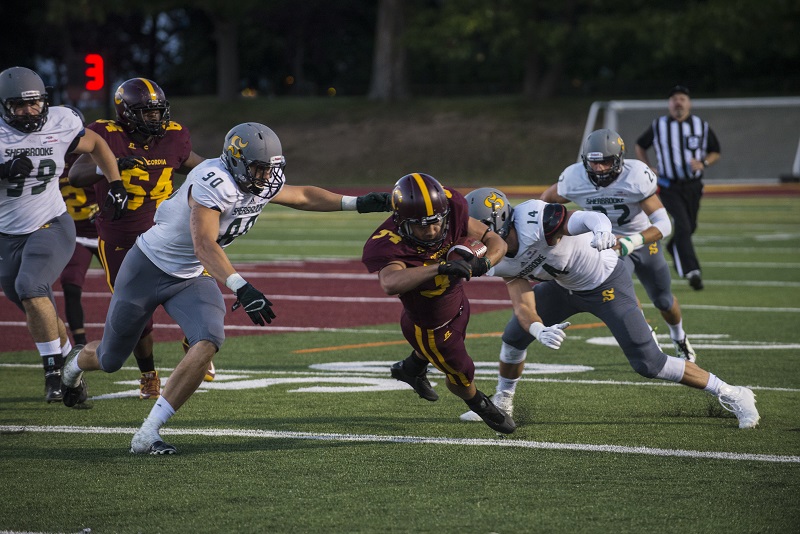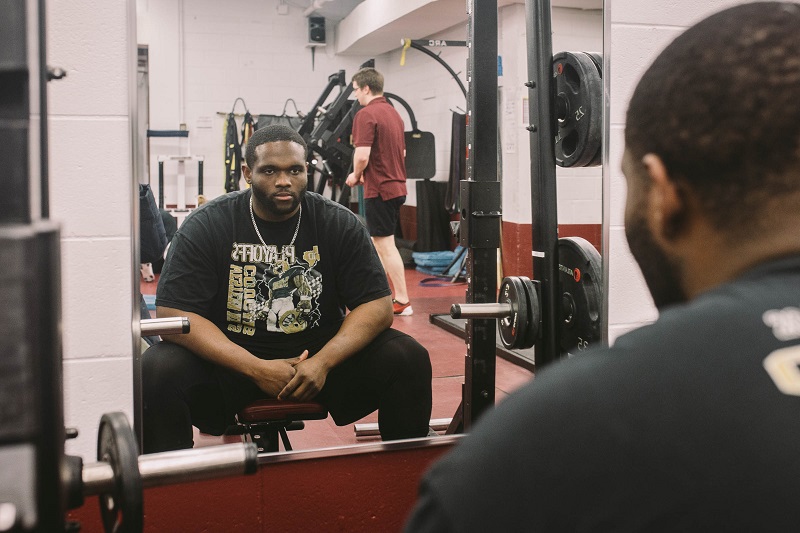Three seasons after tearing his ACL, MCL and meniscus, Kenny Johnson is making his comeback
Kenny Johnson hasn’t played in a U Sports football game for the Concordia Stingers since 2015. Three years and three surgeries later, Johnson is finally healthy and set to return to the field to play in his last year of eligibility.
On Sept. 4, 2015, the offensive guard tore the anterior cruciate ligament (ACL), medial collateral ligament (MCL) and meniscus in his left knee, an injury also known as “the unhappy triad.”
It was the home opener for the Stingers, and they were playing the Sherbrooke Vert et Or. It was Johnson’s second year with Concordia.

“Our kicker missed the field goal,” Johnson said. “The receiver for Sherbrooke caught it, so he was running down the field. I went running downfield to make the tackle, and a defender was coming at me. I didn’t see him. He blindsided me, and my knee just twisted and I buckled. I collapsed, slapping the ground […] The athletic trainers asked me to get up, and I couldn’t. It was too painful.”
“I wouldn’t wish this on anybody,” he added.
The Stingers lost that game 37-0.
It took a couple of days before the swelling from the initial injury went down. After getting an MRI scan, team doctors broke the news to Johnson that he had blown out his left knee.
“I was still in denial,” Johnson said. “Right in front of the doctor, I started crying. I straightened myself out, I called my mother—that was the first person I could call. I explained to her what happened. I was crying on the phone with her, saying ‘my football career is done.’”
ACL injuries are common for football players. A study in the Orthopaedic Journal of Sports Medicine found that 213 players in the National Football League (NFL) had ACL injuries between 2010 and 2013. The same study found that offensive guards, like Johnson, have a significantly higher chance of suffering knee injuries than other positions.
Serge Savoie and Victoria Robinson-Mozejko are two athletic therapy instructors at the PERFORM Centre, a private research facility at Concordia’s Loyola campus. They said the average wait time to receive surgery for torn knee ligaments ranges from a week to a month after the incident, depending on the surgeon. Some surgeons will want to operate right away to reduce the chance of significant muscle loss. Others would rather make sure the athlete is building strength pre-surgery to better prepare for post-surgery rehabilitation.
It took Johnson six months to receive his first surgery. Since he is from Texas, Johnson said he had trouble working through the bureaucracy to get the surgery, which is why it took so long. Once he underwent his operation in March 2016, Johnson said the results were not encouraging. The swelling never went away. He watched as the team prepared for the next season, while he was unable to properly rehabilitate his knee.
Johnson had a lot of confidence going into that 2015 season, and had set high expectations for himself. Once he got injured, Johnson said he lost that confidence. Even though the rest of the team never made him feel like an outsider, that’s how he felt.
“At one point during the recovery, I was really depressed,” Johnson said. “I felt like I didn’t have anyone to talk to […] Anyone who goes through what I went through should have someone they can go to and ask questions to—somebody they can trust. It’s such a difficult thing to go through; you can’t do it by yourself.”
Savoie said watching the team start the season while still being injured is the most difficult aspect of the mental recovery for athletes.
“That season starts, and they see all their teammates going and winning and losing, and they’re on the sideline,” Savoie said. “They get a taste of what it’s like to get back [on the field].”
“The injury is all mental,” Johnson added. “There’s a physical aspect to it, but the mental part is so draining.”
Three months after his first surgery, Johnson went back under anesthesia so doctors could try to manipulate the area surrounding his knee to deal with the excessive swelling and scar tissue. Again, he came out of the surgery not seeing any progress. Johnson still walked with a bad limp and was unable to get back to training or performing the way he had before his injury. It took another six months of frustrating rehabilitation following his second surgery before imaging technology showed Johnson still had large amounts of scar tissue left in his knee. He went back for a third surgery in December 2016 and immediately felt a difference.
“As soon as I was out of surgery, I was able to walk out of the hospital. It wasn’t a perfect walk, but I was able to walk,” Johnson said. “An hour after the surgery, I got on the [exercise] bike for like 30 minutes. I didn’t go hard, I just took it easy, but I knew right away: ‘Okay, this is the surgery that did its job.’ I gained my confidence right back, just like that.”
The comeback began after that third surgery. It has been a long process for Johnson, and the injury caused him to doubt his future in football. He said he thought about quitting, going back home to Texas, and finishing his studies close to his family. But he said that would be “too easy.” As the preparation and training for the 2018 season continues this summer, Johnson has his confidence back and is eager to finally rejoin the team on the field. As a second-year at the time of his injury, Johnson felt ready to fill a leadership role. Now, he’s just hoping to fill whatever role the team needs.
“A lot of people know I can play the game at a high level; I’ve studied the game for a very long time,” Johnson said. “I just want to come in and be a team player first before I adopt that leadership role. If it comes, I’m going to take it, but for me it’s about what I can do to help the team win.”
Main photo by Kirubel Mehari.




